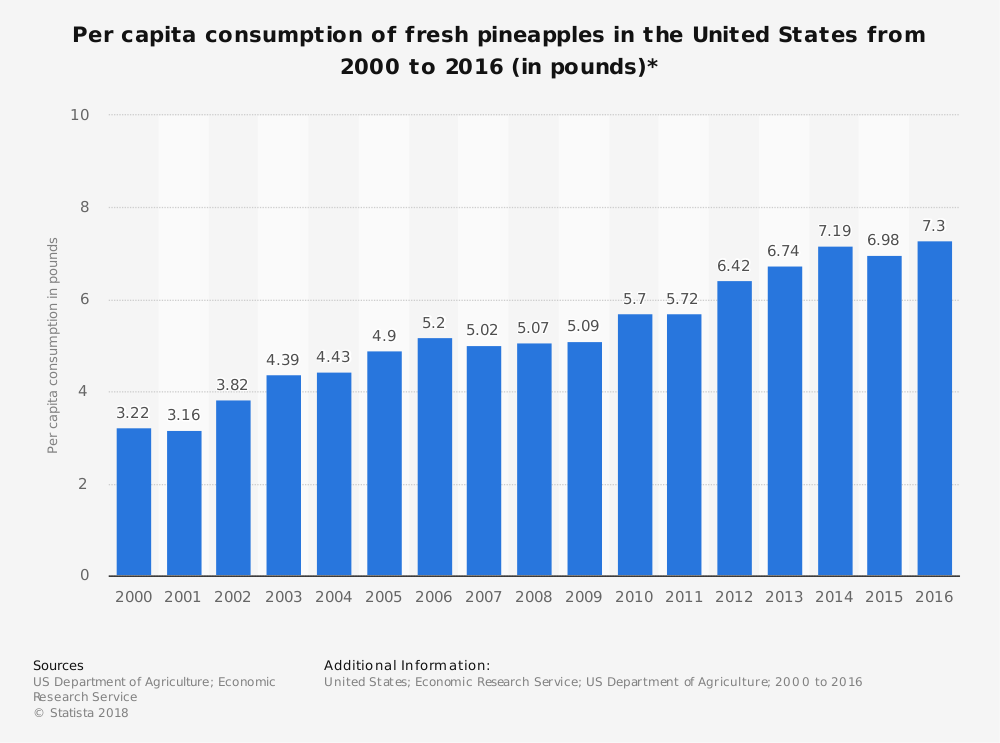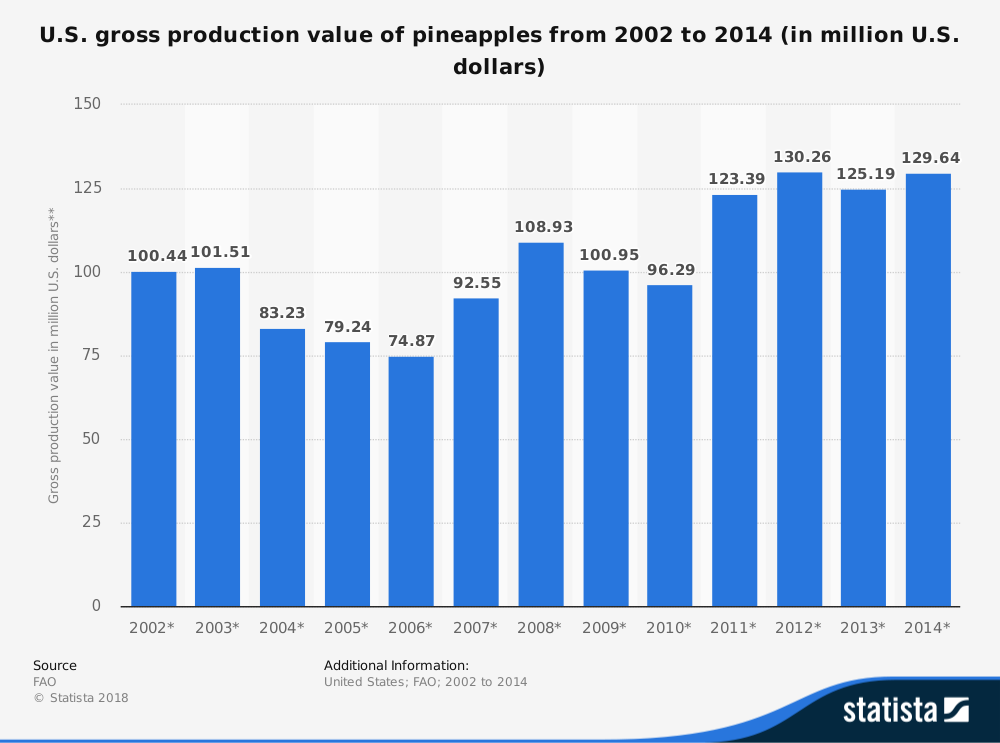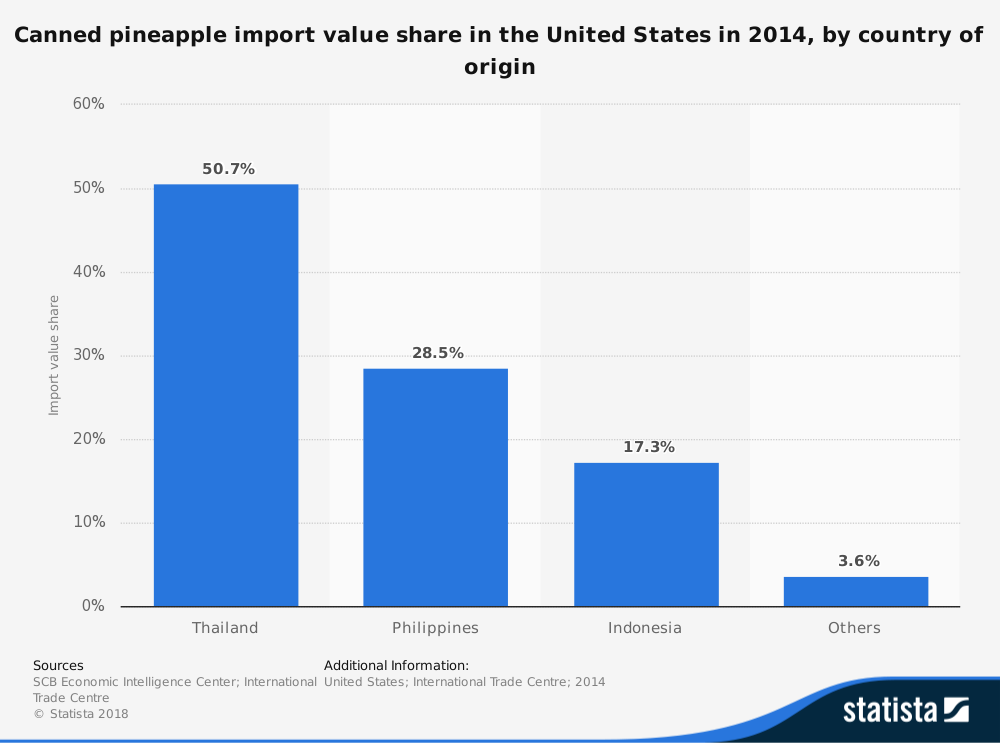Although the largest sectors of the global pineapple industry are located in Southeast Asia, it is believed that the various species of pineapple actually originated in South America. The pineapple industry began to spread in the 16th century and is now considered the most widely traded tropical fruit, with a third of its output in processed form. Here are some interesting pineapple industry statistics to know.
Important Pineapple Industry Statistics
#1. In 2014, the global production of pineapple reached over 25 million metric tons for the first time. This is compared to 2002 production rates if just 15.8 million metric tons. (Statista)
#2. Costa Rica is the world’s largest producer of pineapples. In 2014, the country contributed over 2.9 million metric tons to the global supply. This was followed by Brazil, with 2.6 million metric tons, and the Philippines, with 2.5 million metric tons. (Statista)

#3. Thailand, Indonesia, India, Nigeria, and China all produce more than 1 million metric tons of pineapple for the industry every year. (Statista)
#4. Pineapples represent about 20% of the global production of tropical fruit in the world today. In the last 50 years, global pineapple production levels have risen by over 400%. (Novagrim)
#5. About 70% of the pineapple that is consumed globally is eaten while it is fresh. The average person has about half of the pineapple they eat come from either Brazil, Thailand, the Philippines, or China. (Novagrim)
#6. Since 1980, the total amount of land use in Hawaii for agricultural production, including pineapple, has been reduced by 68%. More than 100 positions within the Hawaii Agriculture Department remain vacant. (Washington Post)
#7. In 1980, Hawaii had 4 pineapple plantations and 14 sugar plantations that covered more than 300,000 acres. In 2017, these two crops had a combined total of 5,000 acres of agricultural space. (Washington Post)
#8. Once planted, it can take more than 2 years for a new pineapple plant to produce its first fruit. (Love Big Island)
#9. Pineapples are the 11th most common cultivated fruit in the world today. In 2013, about 24.8 million tons were produced globally. (FAO)
#10. Between 2000-2013, the global production of pineapples increased by more than 8 million tons. (UNCTAD)

#11. Costa Rica is the top exporter of pineapples, with almost all of the harvest being sent to the export market each year. In the Philippines, just 20% of the production is dedicated to the fresh consumption market. The rest is used for processing purposes. (UNCTAD)
#12. The top 10 exporters of pineapples in the world today account for 97% of the fresh fruit that is available around the world today. (UNCTAD)
#13. About 13% of the total pineapple production levels that are achieved globally each year are dedicated to the export market. (UNCTAD)
#14. Demand for pineapple products is concentrated to North America, Europe, and Japan. In 2014, the United States consumed over 1.19 million metric tons of pineapple. Europe consumed over 934,000 metric tons, while Japan consumed over 166,000 thousand metric tons. (UNCTAD)
#15. The United States and the European Union import as many pineapples in a month as Japan consumes over the course of an entire year, according to published monthly import figures from 2014. (UNCTAD)
#16. In Europe, the top importer of pineapples is the Netherlands, which accounts for over 277,000 metric tons annually. Belgium consumes about 148,000 metric tons of pineapples in any given year as well. (UNCTAD)
#17. Americans, Canadians, and Europeans consume an average of 2 kilograms of pineapple products per year. (UNCTAD)
#18. The processed pineapple market is specifically concentrated on the United States and Europe. About 40% of all wholesale pineapple products that are available for import involve canned fruit. Just one-third of the wholesale pineapple importing opportunities for the U.S. and E.U. markets are for fresh fruit. (Alibaba)
#19. Farmgate prices for pineapples have been rising at rates that are consistent with production levels. Formosa pineapples have seen the highest levels of price growth, achieving an annual average rate of over 7.7%. Red Spanish pineapples have seen price growth rates averaging 3% annually, while Cayenne pineapples have seen price growth rates average just over 2.8%. (Food and Fertilizer Technology Center)
#20. Top exporters of pineapples have recovered from the recession years of 2007-2009 to experience average annual growth rates that are as high as 11% in the Philippines. (Food and Fertilizer Technology Center)

#21. Pineapple exports tend to focus on regional shipments to preserve the quality of the fruit. Japan, for example, accounts for almost 90% of the total export market for pineapples that originate in the Philippines. (Food and Fertilizer Technology Center)
#22. About 300 billion pineapples are farmed every year around the world. About 400 million of those pineapples still come from Hawaii, usually between the months of March and July. That means Hawaii accounts for 0.13% of the global pineapple industry. (Smithsonian Magazine)
#23. In 1901, Dole opened the Hawaii Pineapple Company. By 1923, they were the largest provider of pineapples to the world. Eight companies dominated the market through the 1940s, providing employment to over 3,000 people on the islands. (Smithsonian Magazine)
Pineapple Industry Trends and Analysis
The pineapple is a unique product. It isn’t a single fruit, like some may believe, but a collective fruit because it is a group of berries that fuse together. Eating pineapple provides a good dose of Vitamin C. Pineapples also contain bromelain, which breaks down proteins quite effectively. The bromelain is so strong, in fact, that long-term pineapple harvesters may not have fingerprints because the proteins in their skin have broken down.
Under-developed markets could be reached within the next decade to help the industry continue its expansion efforts. Look for shipment efforts to increase to Russia, the Middle East, and Eastern Europe as logistics chains mature.
The pineapple industry has seen some changes over the past century. New sectors are springing up as once dominant regions, like Hawaii, move in a different direction. With a long tradition of growth and increasing sales, the pineapple industry looks to continue down a path toward consistent success.
Although millions of people visit Brandon's blog each month, his path to success was not easy. Go here to read his incredible story, "From Disabled and $500k in Debt to a Pro Blogger with 5 Million Monthly Visitors." If you want to send Brandon a quick message, then visit his contact page here.
